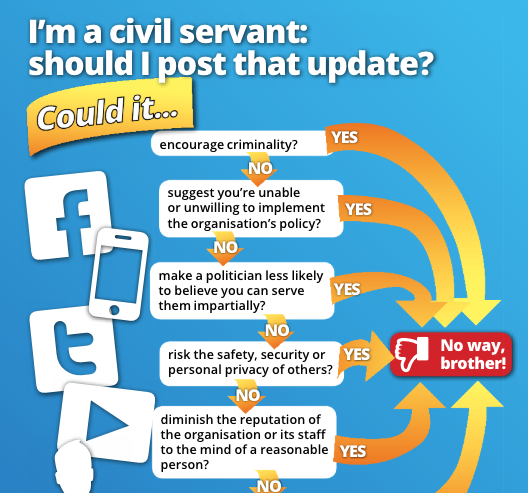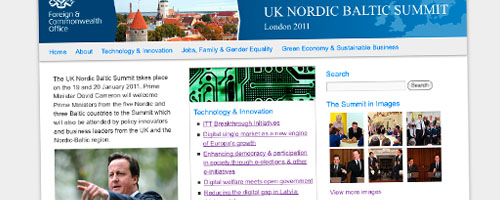The Teacampers were on good form (and vast numbers) yesterday, to discuss the vexed question of social media guidance for civil servants which the GDS Digital Engagement team are currently drafting. It’s to their great credit that Emer, Lou, Jane and colleagues are developing the guidance in the open, in consultation with those inside and outside government who have an interest or experience. It’s a tough challenge too – my contribution was to suggest that maybe we need several different things, rather than a single one (which others have struggled to compile before – it quickly becomes a social media training manual or digital engagement strategy when you put finger to keyboard…):
- An overarching vision for how government or a particular organisation intends to use social media to advance its aims, with a sort of set of ‘design principles’ to guide how it will be practiced.
- Some descriptions of how an organisation will manage its different social channels, why it has them, who controls how they’re used, and how their value will be measured. It helps people inside and outside be clear on what to expect, and is a source of answers when someone asks, which they invariably will.
- Some examples of how to use social media effectively as a team, and as an individual whether that’s the Head of the Civil Service or a countryside ranger.
- A minimal set of rules for an individual to follow, by their very existence providing some reassurance that it’s OK to engage online while also clarifying which rules apply. I don’t underestimate how tough these are to get right – as a Teacamper joked, people who use social media don’t read social media guidelines, and people who read social media guidelines don’t use social media. The existing bullet points aren’t enough, and it’s hard to know just which existing staff policies apply to social media. Without this, it’s easy to slip into paranoia and feel the world is out to get you. Sure, some folk are and the Daily Mail always has pikestaffs needing heads. With some sensible rules, it’s more likely a press officer or line manager will defend a colleague under attack, as defend they should. As a taxpayer, I want to deal with a civil service of interesting, helpful human beings, not a humourless bureaucracy.
Still, my contribution to #4 is Helpful Technology’s first venture into infographics (not a proper one, I know but in the same visual style), in the form of this eight question flowchart to help you work out whether the pearl of wisdom you’re about to tweet or post is le mot juste or beyond the pale. It’s a minimum set, and would allow people to tweet about bad days or things that they’re struggling with, while avoiding the things that harm the ability of government to work. See what you think.



Comments
Needs a complementary set of risks on Does Not Posting this update
– cause people unnecessary work
– put people at risk
– lose transparency and trust
– lead to costs elsewhere
etc
Civil servants do not generally need support to timidity and secrecy.
Like it. But could it be made simpler?
Shouldn’t it just be:
“Would you say this in front of:
1) your colleagues?
2) your boss?
3) a journalist?
4) someone you really respect?”
If the answer is ‘no’ to any of the above then think again before you post. Just assume that anyone might see it.
Agree 100%. Your comments yesterday echoed with spooky accuracy the points I was scribbling while listening to other teacampers – lets hope we end up with something along those lines: clear drive from the top that its OK to do this; departments with clear frameworks for what they are focusing on and why; and material such as your chart above – reassurance for people new to social media (presumably an ever shrinking group, but still at the moment a sizable community). Plus – not to forget, a well curated and publicised set of examples of people and departments doing things well.
I’d like to add something to this. Clear paths to follow when things go wrong – on either side.
We’ll do our very best. The problem with crowd sourcing of course sometimes being ‘everyone’s an expert’ cos they are, and ‘you can’t keep all the people happy all of the time’.
Next iteration is being worked on tomorrow.
As ever, brilliant post.
Examples and case studies are a difficult one – someone mentioned in the feedback round that they quickly go out of date. How do we mitigate this?
Well, the principles of good engagement online are pretty enduring, even though the tools come and go.
The plan behind the Digital Engagement Guide is to build up the variety of examples, loosely organised, so when you need to find something for a particular context – say helping a senior colleague to start tweeting, or helping a policy official try sourcing consultation input online – then there are at least some examples which are both fresh and hopefully good.
I think it’s an argument for keeping the guidance pretty concise and referring to other places (your blog, the Guide, events like Teacamp) where people can find out how others are doing it, and learn the ropes.
Visually the infographic worked brilliantly for me Steph. I featured it (and you) in my latest blogpost: “Do civil servants have private lives anymore?” http://adragonsbestfriend.wordpress.com/2012/04/13/do-civil-servants-have-private-lives-anymore/
My blog not appropriate for this. But a crowd sourced list of good examples/sources is something which should probably go on a blog. Brilliant, thank you. That’s the writers block neatly sorted.
We’ve already decided to ditch much of the ‘toolkit’ we were working on and replace it with your guide Steph.
(we being the Scottish Government :))
[…] There’s a bit more context to it on the accompanying blog post […]
I’ve yet to see a better litmus test (in the public sector) than ‘would you mind seeing this on the front page of the Daily Mail?’
That masks a lot of complexity but is the quickest, most intuitive risk assessment I’ve encountered.
Thing is, the Mail will hardly ever give government a fair hearing, and lots of things that should be said and done would understandably be shy of the Mail’s scrutiny.
My key point with these rules is really the green box at the bottom: if it’s not bad, it’s good – and you should go for it, citizen. Don’t let the Mail, or a nervous HR manager or press officer, hold you back from doing your job properly with modern tools.
[…] If there is once piece of information people new to public sector social media should take away, it’s this poster. Then there is the social media crisis simulator – which I’d love to see in action in […]